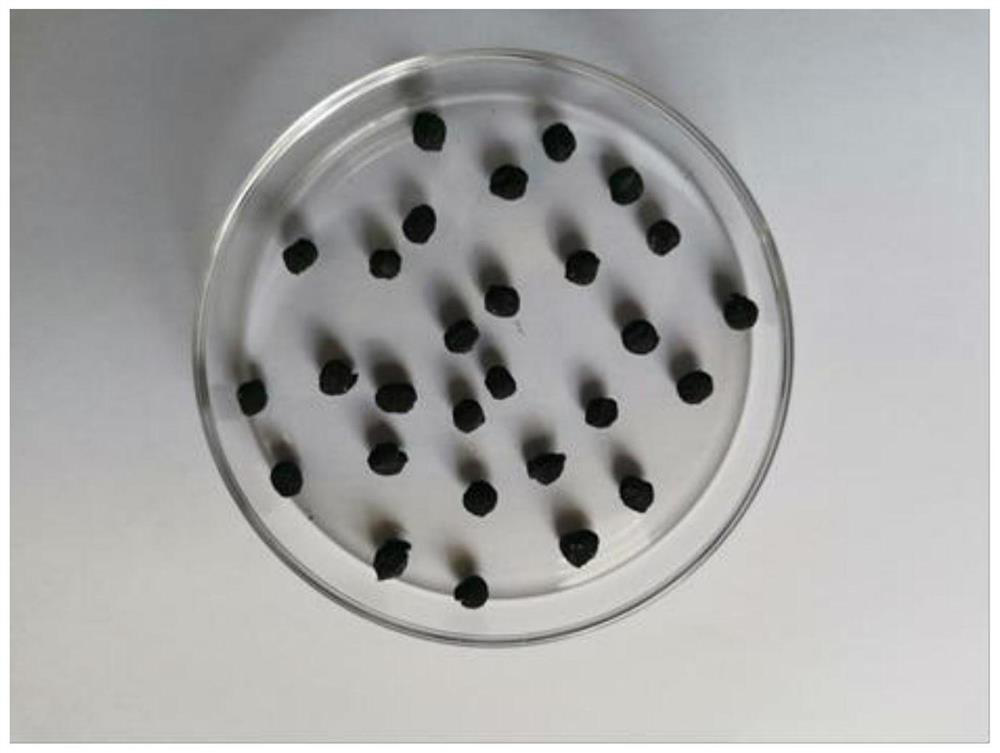A preparation method of lithium ion sieve adsorbent particles for extraction of liquid lithium resources
An adsorbent, lithium ion technology, applied in chemical instruments and methods, other chemical processes, alkali metal compounds, etc., can solve the problems of reduced adsorption capacity, poor water permeability of adsorbent particle matrix materials, slow adsorption process, etc.
- Summary
- Abstract
- Description
- Claims
- Application Information
AI Technical Summary
Problems solved by technology
Method used
Image
Examples
Embodiment 1
[0074] An adsorbent particle for liquid lithium resource extraction is carried out in the following manner:
[0075] The first step, the spinel type Li 4 Ti 5 O 12 It is dried at 80°C and pulverized to a particle size of 800-1000 mesh by a high-speed pulverizer to obtain adsorbent powder.
[0076] In the second step, polyvinyl alcohol with an alcoholysis degree of 85% is dissolved in water to prepare a 10wt% polyvinyl alcohol aqueous solution.
[0077] Step 3: Mix the polyvinyl alcohol aqueous solution with the adsorbent powder in a mass ratio of 3:1, and use a three-roll mill to mix evenly.
[0078] The 4th step, adding a certain amount of the first cross-linking agent aqueous solution to the mixture obtained in the third step, wherein the first cross-linking agent aqueous solution wherein the mass ratio of the mixture to the first cross-linking agent solution is 1:2, the said The composition of the first crosslinking agent aqueous solution is 3wt% boric acid, 1wt% borax,...
Embodiment 2
[0085] An adsorbent particle for liquid lithium resource extraction is carried out in the following manner:
[0086] The first step, the spinel type Li 1.6 Mn 1.6 O 4 Drying at 80°C, pulverizing to a particle size of 800-1000 mesh by a high-speed pulverizer to obtain adsorbent powder;
[0087] Step 2: Dissolve polyvinyl alcohol with an alcoholysis degree of 85% in water to prepare a 10wt% solution
[0088] Step 3: Dissolving sodium polyacrylate with an average molecular weight of 1.25 million in water to prepare a solution with a concentration of 3wt%.
[0089] In the fourth step, the polymer aqueous solutions prepared in the second and third steps are mixed according to a mass ratio of 10:1, and mixed evenly with a high-viscosity stirring paddle to obtain a high-viscosity polymer mixed solution.
[0090] Step 5: Add the adsorbent powder from Step 1 into the high-viscosity polymer mixed solution from Step 4 and mix at a mass ratio of 1:3, and stir or grind until the mixtur...
Embodiment 3
[0096] An adsorbent particle for liquid lithium resource extraction is carried out in the following manner:
[0097] The first step, the spinel type Li 4 Ti 5 O 12 The adsorbent powder is dried at 80°C, and pulverized to a particle size of 800-1000 mesh by a high-speed pulverizer to obtain adsorbent powder;
[0098] Step 2: Dissolve polyvinyl alcohol with an alcoholysis degree of 85% in water to prepare a 10wt% solution
[0099] In the third step, polyacrylic acid with an average molecular weight of 1.25 million is dissolved in water to prepare a solution with a concentration of 4wt%.
[0100] Step 4. Dissolve sodium alginate in water to prepare a 3wt% solution
[0101] Step 5: Mix the polymer aqueous solutions prepared in steps 2, 3 and 4 according to a mass ratio of 10:1:1, and use a high-viscosity stirring paddle to mix evenly to obtain a high-viscosity polymer mixed solution.
[0102] Step 6: Add the adsorbent powder of Step 1 into the high-viscosity polymer mixed sol...
PUM
| Property | Measurement | Unit |
|---|---|---|
| particle size (mesh) | aaaaa | aaaaa |
| hardness | aaaaa | aaaaa |
| water content | aaaaa | aaaaa |
Abstract
Description
Claims
Application Information
 Login to View More
Login to View More - R&D
- Intellectual Property
- Life Sciences
- Materials
- Tech Scout
- Unparalleled Data Quality
- Higher Quality Content
- 60% Fewer Hallucinations
Browse by: Latest US Patents, China's latest patents, Technical Efficacy Thesaurus, Application Domain, Technology Topic, Popular Technical Reports.
© 2025 PatSnap. All rights reserved.Legal|Privacy policy|Modern Slavery Act Transparency Statement|Sitemap|About US| Contact US: help@patsnap.com


